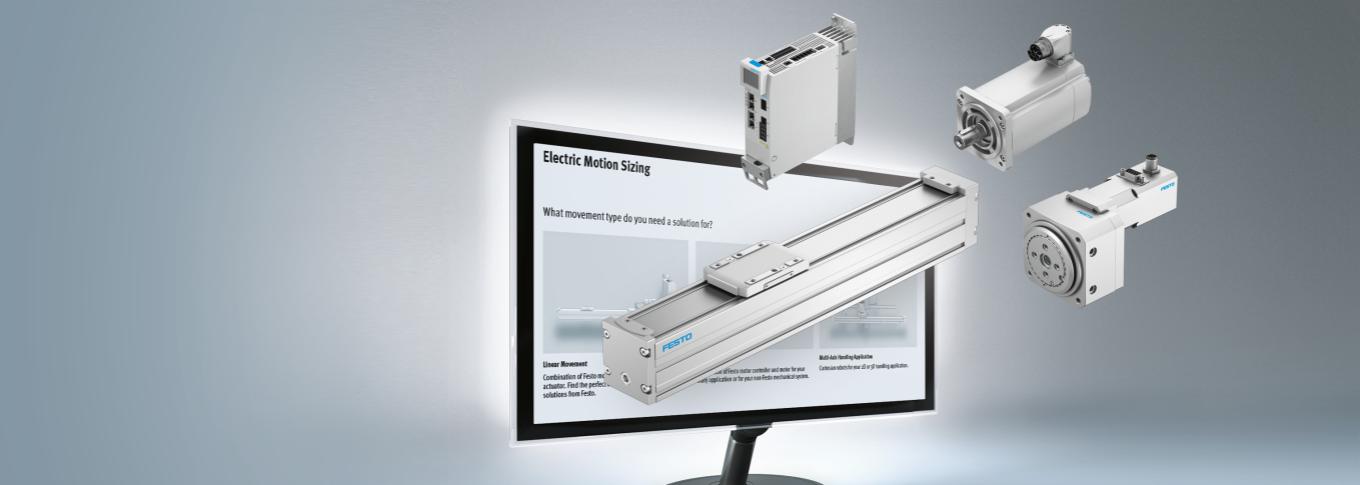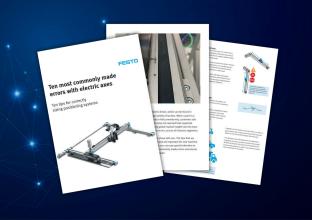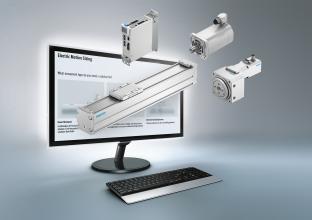
Top tips to improve your next electric drive system’s performance
Electric automation can deliver enhanced efficiency, consistency and precision over traditional pneumatics in many industrial automation applications. However, simple oversights during design and specification can cause serious problems, turning your electric automation dream into the ‘axis of all evil’, according to industrial automation specialist Festo.
“Mistakes we commonly see include undersized motors on vertical axes, incorrect gear ratios, and a failure to align the guides correctly — all causing sub-optimal machine performance and premature component failure,” says Ben Lloyd, EA Product Manager at Festo. The knock-on effects for end users can include higher energy consumption, increased maintenance costs, and lower productivity.
Based on the findings from investigations into premature component failure, Festo has compiled 10 Most Commonly Made Errors With Electric Axes, a free-to-download guide that identifies common errors and offers best practice advice for optimising electric automation system performance. Festo’s top tips include:
1. Factor in vibration
When selecting a linear axis, specifiers rightly refer to the manufacturer’s datasheet to obtain information regarding the correct power and torque parameters. However, environmental conditions such as vibrations must also be factored in to ensure that the desired lifetime is achieved. Failure to consider environmental conditions can result in a much shorter actual life time than predicted, based on your chosen power and torque.
More accurate predictions of component lifetime can be achieved by applying a specific factor to the load, as a function of the expected vibration, during the calculations. This factor lies between 1³ and 2³ and indicates the strength of the impact of the vibrations on the lifetime. The datasheet for each component will state how the impact of vibrations on the service life can be calculated.
2. Ensure full lubrication
Electric automation components are sometimes required to make repeated very short and precise movements. This can pose problems with effective lubrication, which leads to components sticking or failing. For example, a ball screw drive has a grease reservoir that ensures the drive is continuously lubricated during operation. In applications in which only a very limited stroke length is used, the balls in the ball screw assembly hardly move at all and so are not coated with any new grease.
In such cases, an extended stroke, or “lubrication stroke”, should be made periodically. Ideally, this action would be programmed into the machine software: for instance at the end of every shift or every production series. Lubrication requirements must be considered during the design phase to ensure that a movement over a longer stroke length is possible.
3. Thermal performance
The thermal model of the motor and drive plays an important role in correct drive selection. Heating and cooling cycles are typically influenced by whether the application requires the electric drive to operate continuously or intermittently. In applications with intermittent operation, the components have time to cool down. This has a positive impact on their service life, which means it is often possible to select a less powerful version than for continuous operation.
Festo’s Electric Motion Sizing tool helps specifiers and machine builders to factor this in. Users simply enter the dwell times between the movements alongside other typical application requirements such as motion, mass and speed. The online tool provides additional helpful manufacturer-independent tips for consideration in new machine designs.
Considering vibration, lubrication and thermal performance are just three ways to improve your electronic drive’s performance and life cycle. However, for a broader overview Festo has gathered more tips, based on its experience in the field, and compiled them into a free-to-download guide called Ten Most Commonly Made Errors With Electric Axes. Use it next time you design a system to avoid making avoidable errors and ensure that your electric drives last their full life span.
Festo’s 10 Most Commonly Made Errors With Electric Axes can be downloaded here: www.festo.com/common_errors_electric_axis
About Festo
Festo is a leading international supplier of automation technology with a turnover in 2024 of around €3.45 billion. Festo employs over 20,000 people worldwide and is a proven innovator and problem solver in pneumatic and electrical automation, where it is the performance leader. Festo offers around 36,000 pneumatic and electric products in hundreds of thousands of variants for factory and process automation technology, many of which can be tailored to specific customer needs. Sustainability, reducing its CO2 footprint, digital learning, innovation, performance and speed are the key drivers for the company's future. Festo GB operates as a carbon neutral organisation and uses the PAS 2060 standard externally audited by NQA to validate this claim to customers, employees and other stakeholders.
Festo Industrial Automation's innovative strength is demonstrated through the launch of around 100 new products every year. The company invests over 8.5% of its turnover in R&D, resulting in over 2,600 patents held worldwide. For more information about the company's products and UK / Irish services, please visit: www.festo.com/gb and www.festo.com/ie
Festo and Industry 4.0 - Festo has engaged with the Industry 4.0 initiative from its inception: as a user, manufacturer and trainer. As a member of the steering group, the company has taken an active role in defining the core standards such as the RAMI model and the Administration Shell. Festo Didactic has installed Industry 4.0 Cyber-Physical Factory training hardware systems in many leading universities and training centres. It also provides Industry 4.0 training courses for change managers and practical workshops for employees. Industry 4.0 technologies such as OPC-UA communications are embedded in the latest generation products. For more information, go to www.festo.com/digitalisation
Festo Didactic training delivers training for industry – by industry. Combining Festo's industrial heritage with its future-focused manufacturing and engineering expertise to deliver courses for greater productivity and competitiveness. Offering a wide range of open courses, structured development programmes and tailor-made, customer-specific projects on technology and Industry 4.0 and the industry-leading online training suite, Festo LX. Festo also provides state-of-the-art training equipment solutions for industrial companies and educational institutions around the world. Festo Didactic has around 56,000 education customers worldwide. More information on Festo training and consulting services can be found at: www.festo.com/didactic
Festo Bionic Learning Network encapsulates the innovative nature of Festo, raising awareness and attracting talent to the company. Exploring the links between nature and technology opens new areas of innovation and demonstrates complex ideas in a stimulating and enjoyable way. Festo works with an alliance of internal R&D, external educational establishments and specialist companies to advance bionic solutions for automation applications of the future. The objective is to benefit from bionics as a source of inspiration and to realise these in industrial automation. For more information about Festo's Bionic Learning Network, please visit: www.festo.com/bionics


